Eton VIPER 50 SERVICE MANUAL
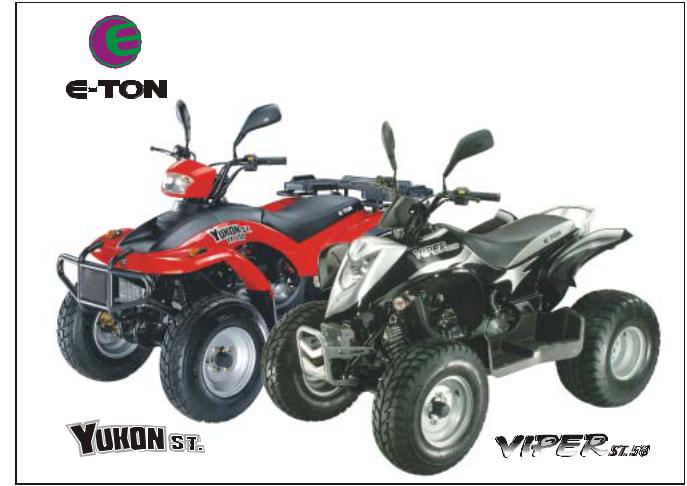
SERVICE MANUAL
CONTENTS
1.INFORMATION
2.MAINTENANCE
3.ENGINE REMOVALAND INSTALLATION
4.ENGINE FUEL SYSTEM
5.ENGINE LUBRICATION AND COOLING SYSTEM
6.ENGINE COMBUSTION SYSTEM
7.TRANSMISSION SYSTEM
8.STEERING SYSTEM
9.FRONT WHEEL SYSTEM
10.REAR WHEEL SYSTEM
11.FENDERS AND EXHAUST PIPE
12.ELECTRICAL SYSTEM
13.TROUBLE SHOOTING
1. INFORMATION
1.1 |
SAFTY |
1.4 |
SERIAL NUMBER |
1.2 |
NOTES |
1.5 |
TORQUE VALUE |
1.3 |
SPECIFICATION |
|
|
|
|
|
|
1.1 SAFETY
GASOLINE
Gasoline is extremely flammable and is explosive under certain condition. Do not smoke or allow sparks or flames in your work area.
● CARBON MONOXIDE
Never run the engine in a closed area. The exhaust contains poisonous carbon monoxide gas that may cause loss of consciousness and lead to death.
● BATTERY ELECTROLYTE
The battery electrolyte contains sulfuric acid. Protect your eyes, skin and
clothing. If you contact it, flush thoroughly with water and call a doctor if electrolyte gets in your eyes.
● HOT PARTS
Engine and exhaust pipe become very hot and remain hot for one hour after the engine is run. Wear insulated gloves before handling these parts.
● USED ENGINE/GEAR OIL
Used engine oil and gear oil may cause skin disease if repeatedly contact with the skin for long periods.
Keep out of reach of children.
1.2 NOTES
All information, illustrations, directions and specifications included in this publication are base on the latest product information available at the time of approval for printing.
JI-EE Dynamic Technology Industry Co., Ltd. reserves the right to make changes at any time without notice and without incurring any obligation whatever.
No part of this publication may be reproduced without written permission.
2

1.3 SPECIFICATION ENGINE (for ViperST & YukonST |
in this service manual) |
|
||||||
|
|
|
|
|
|
|
|
|
|
Type |
|
|
|
|
|
Two cycle air cooled |
|
|
Displacement |
|
|
|
|
|
49.3 c.c. |
|
|
Bore and Stroke |
|
|
|
|
|
40.0X39.2mm |
|
|
Compression ratio |
|
|
|
|
|
6.8:1 |
|
|
Maximum Torque (Nm/rpm) |
|
|
|
4.5 Nm/6000rpm |
|
||
|
Maximum Power (ps/rpm) |
|
|
|
3.8 ps/6000rpm |
|
||
|
|
|
|
|
|
|
|
|
|
Carburetor |
|
|
|
|
|
Piston type |
|
|
Ignition |
|
|
|
|
|
Capacitor Discharge |
|
|
Starting |
|
|
|
|
|
Electric and kick starter |
|
|
Lubrication |
|
|
|
|
Forced pressure and wet sump |
|
|
|
Transmission |
|
|
|
|
Automatic (C.V.T. V-belt) Fr Neut .Rev |
|
|
|
|
|
|
|
|
|
|
|
|
CHASSIS |
|
ViperST |
EXL-50 |
|
YukonST |
EXL-50 |
|
|
|
|
|
|||||
|
|
|
|
|
|
|
|
|
|
Overall Length |
|
1670 mm |
|
|
1750 mm |
|
|
|
Overall Width |
|
940 mm |
|
|
1010 mm |
|
|
|
Overall Height |
|
1040 mm |
|
|
1065 mm |
|
|
|
Seat Height |
|
760 mm |
|
|
760 mm |
|
|
|
Wheel base |
|
1110 mm |
|
|
1115 mm |
|
|
|
Ground Clearance |
|
120 mm |
|
|
120 mm |
|
|
|
Dry Weight |
|
152 kg |
|
|
152 kg |
|
|
|
Fuel Tank Capacity |
|
4.5 Liters |
|
|
4.5 Liters |
|
|
|
|
|
|
|
|
|
|
|
|
|
|
ViperST |
EXL-50 |
|
YukonST |
EXL-50 |
|
|
SUSPENSION |
|
|
|
|
|
|
|
|
Front |
|
Single A-arm / Adjustable Shocks |
|
|
|||
|
|
|
|
|
|
|
|
|
|
Rear |
|
Swing Arm / Adjustable Shock |
|
|
|||
|
BRAKES |
|
|
|
|
|
|
|
|
Front |
|
|
|
Dual Mechanical drum |
|
||
|
Rear |
|
|
|
|
Hydraulic Disc |
|
|
|
TIRES |
|
|
|
|
|
|
|
|
Front |
|
|
|
20/6-10 |
|
|
|
|
Rear |
|
|
|
20/10-9 |
|
|
|
|
PRESSURE psi |
(0.23 kgf/cm2) |
|
|
|
|
||
|
Front |
12(0.8) |
|
|
|
12(0.8) |
|
|
|
Rear |
12(0.8) |
|
|
|
12(0.8) |
|
|
COLORING
Specifications subject to change without notice.
3
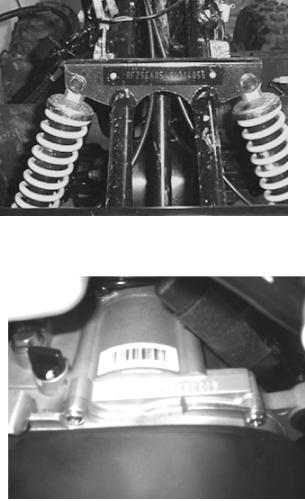
1.4 SERIAL NUMBER
(For ViperST EXL-50 / YukonST EXL-50 in this service manual)
The frame serial number is stamped on the front of the frame.
The engine serial number is stamped on the left side of the crankcase.
Frame serial number
Engine serial number
4
.5 TORQUE VALUES
(For EXL 50 in this service manual)
STANDARD
● 5 mm bolt and nut |
5 |
N.m (3.5 lbf.ft) |
|
● |
6 mm bolt and nut |
10 |
N.m (7.2 lbf.ft) |
● |
8 mm bolt and nut |
22 N.m (16 lbf.ft) |
|
●10 mm bolt and nut |
35 N.m (25 lbf.ft) |
||
●12 mm bolt and nut |
55 N.m (40 lbf.ft) |
||
ENGINE
● Cylinder head nut |
28 N.m (20.7 lbf.ft) |
||
● Spark plug |
12 |
N.m (8.9 lbf.ft) |
|
● |
Cylinder head bolt |
20 N.m (14.8 lbf.ft) |
|
● |
Alternator bolt |
8 |
N.m (5.9 lbf.ft) |
FRAME
● Handlebar upper holder bolt |
24 N.m (17.7 lbf.ft) |
|
● Throttle housing cover screw |
4 |
N.m (2.9 lbf.ft) |
● Steering shaft nut |
50 N.m (36.9 lbf.ft) |
|
● Steering shaft holder bolt |
33 N.m (24 lbf.ft) |
|
● Wheel rim bolt |
18 N.m (13.3 lbf.ft) |
|
● Tie rod lock nut |
35 N.m (25.8 lbf.ft) |
|
● King pin nut |
40 N.m (29 lbf.ft) |
|
● Handlebar lower holder nut |
40 N.m (29.5 lbf.ft) |
|
● Front wheel bolt |
24 N.m (17.7 lbf.ft) |
|
● Front axle castle nut |
40-60 N.m (30-45 lbf.ft) |
|
● Front brake arm nut |
4 |
N.m (3.0 lbf.ft) |
● Rear brake arm nut |
7 |
N.m (5.2 lbf.ft) |
● Rear axle castle nut |
40-60 N.m (30-45 lbf.ft) |
|
● Rear wheel bolt |
24 N.m (17.7 lbf.ft) |
|
● Exhaust muffler mounting bolt |
30 N.m (22.1 lbf.ft) |
|
● Engine hanger bolt |
30 |
N.m ( 22 lbf.ft) |
● Rear axle holder bolt |
90 N.m (65 lbf.ft) |
|
● Swing arm pivot nut |
90 N.m (65 lbf.ft) |
|
● Rear shock absorber mounting nut |
45 N.m (33 lbf.ft) |
|
5
2. MAINTENANCE
2.1 MAINTENANCE DATA |
2.8 IDLE SPEED |
2.2 MAINTENANCE SCHEDULE |
2.9 DRIVE CHAIN |
2.3 FUEL TUBE |
2.10 BRAKE SYSTEM |
2.4 THROTTLE OPERATION |
2.11 WHEELS AND TIRES |
2.5 THROTTLE CABLE ADJUSTMENT |
2.12 STEERING SYSTEM |
2.6 AIR CLEANER |
2.13 TOE-IN |
2.7 SPARK PLUG |
2.14 GEAR OIL |
2.1 MAINTENANCE DATA
SPECIFICATION
SPARK PLUG: |
|
|
SPARK PLUG GAP: |
0.6-0.7 |
mm |
RECOMMENDED SPARK PLUGS: |
NGK BPR7HS |
|
THROTTLE LEVER FREE PLAY: |
5-10 |
mm |
IDLE SPEED: |
1800±100 |
rpm |
BRAKE LEVER FREE PLAY: |
15-25 mm |
|
DRIVE CHAIN SLACK |
10-25 |
mm |
FRONT/REAR TIRE PRESSURE |
MIN 2 psi (12.5kpa) |
|
TOE-IN |
5±10 mm |
|
TORQUE VALUES
SPARK PLUG |
25-30 N.m |
TIE-ROD LOCK NUT |
35-43 N.m |
ENGINE OIL |
JASO FC Grade or same degree oil |
GEAR LUBRICATION OIL |
SAE 90 |
2.2 MAINTENANCE SCHEDULE
The maintenance internals in the follow table is based upon average riding, conditions. Riding in unusually dusty areas, require more frequent servicing. (For ATV all serial in this service manual)
|
|
INITIAL SERVICE |
REGULAR SERVICE |
EVERY YEAR |
|
|
(First week) |
(Every 30 operating days) |
|
FUEL LINE |
|
|
|
I |
THROTTLE OPERATION |
|
I |
I |
|
AIR CLEANER |
|
|
C |
|
SPARK PLUG |
|
|
I |
|
CARBURETOR IDLE SPEED |
|
I |
I |
|
DRIVE CHAIN |
|
I, L |
I, L |
|
BRAKE SHOE WEAR |
|
|
|
I |
BRAKE SYSTEM |
|
I |
I |
|
NUT, BOLT, FASTENER |
|
I |
I |
|
WHEEL |
|
I |
I |
|
STEERING SYSTEM |
|
|
|
I |
SUSPENSION SYSTEM |
|
|
|
I |
C.V.T. AIR FILTER |
|
|
C |
|
GEAR OIL |
|
|
|
R |
REVERSE GEAR OIL-RXL90R |
|
|
|
R |
Note – I: Inspect and Clean, Adjust, |
Lubricate or Replace, |
if necessary |
|
|
C: Clean |
L: Lubricate |
R: Replace |
|
|

2.3 FUEL TUBE
Inspect the fuel lines for deterioration, damage or leakage and replace if necessary.
2.4 THROTTLE OPERATION
Inspect for smooth throttle lever full opening and automatic full closing in all steering positions. Inspect if there is no deterioration, damage or kinking in the throttle cable, replace it if necessary.
Check the throttle lever, free play is 5-10 mm at the tip of the throttle lever.
Disconnect the throttle cable at the upper end. Lubricate the cable with commercially lubricant to prevent premature wear.
2.5 THROTTLE CABLE ADJUSTMENT
Slide the rubber cap of the adjuster off the throttle Housing, loosen the lock nut and adjust the free play
of the throttle lever by turning the adjuster on the throttle housing. Inspect the free play of the throttle lever.

2.6 AIR CLEANER
Unscrew the air cleaner cover screws.
Pull out the air filter element from the air cleaner case. Wash the element in non-flammable solvent, squeeze out the solvent thoroughly.
Let it dry.
Soak the filter element in gear oil and then squeeze out the excess oil.
Install the element into air cleaner carefully.
2.7 SPARK PLUG
This spark plug located at the front of the engine. Disconnect the spark plug cap and unscrew the spark plug. Check the spark plug electrodes for wearness.
Change a new spark plug if the electrodes and insulator tip appear unusually fouled or burned.
Discard the spark plug if there is apparent wear or if the insulator is cracked or chipped.
The spark plug gap shall keep in 0.6-0.7mm.
With the sealing washer attached, thread the spark plug in
by hand to prevent cross threading.
Tighten the spark plug with 25-30 N.m
2.8 IDLE SPEED
Connect an engine speed meter.
Warm up the engine, 10 minutes are enough.
Turn the idle-speed adjust screw on the carburetor
to obtain the idle speed. “Turn in” (clockwise) will get higher speed. “Turn out” (counter clockwise) will get lower speed.
IDLE SPEED: 1800±100 rpm
2.9 DRIVE CHAIN
Inspect the chain slack. The standard is 10-25mm.

Adjust the chain slack.
Loose the lock bolts (4 pcs) then adjust the drive chain slack by turn the adjusting nut.
Tighten the four lock bolts.
When the drive chain becomes very dirty, it should be removed, cleaned and lubricated by specify lubricator. Using commercial chain lubricant to lubricate the drive chain.
Clean the drive chain with kerosene and wipe it dry. Inspect the drive chain for possible wear or damage. Replace the chain, if it is worn excessively or damaged.
Inspect the sprocket teeth, if it is excessive wear or damage, replace it.
Inspect the chain-tensioned roller.
Replace it, if necessary.
2.10 BRAKE SYSTEM
Inspect the front brake lever and cable for excessive play or other damage.
Replace or repair if necessary.
Measure the free play of the brake lever at the end of the brake lever. The standard of free play is 15-25 mm.

Inspect the rear brake lever and cable for excessive play or other damage.
Replace or repair if necessary.
Measure the free play of the rear brake lever at the end of the lever. The standard is 15-25 mm.
BRAKE SHOE WEAR
FRONT BRAKE
Release the front wheel and inspect the brake lining thickness.
Service Limit: 2.0mm(0.08 inch)
If either lining is worn beyond the service limit, replace Both brakes shoes.
2.11 WHEELS AND TIRES
Inspect the tire surfaces for cuts, nails or other sharp objects. Check the tire surfaces at cold tire condition.
The standard of tire pressure is 1.2±0.3 psi. (0.8 kgf/cm2)
2.12 STEERING SYSTEM
Check the free play of the steering shaft with the front wheels, turned straight ahead.
When there is excessive play, inspect the tie-rod, kingpin bushing and ball joint.

STEERING SHAFT HOLDER BUSHING
Remove the front fender first.
Remove the steering shaft holder and check the steering shaft bushing for wears or damage.
If the bushing is worn or damaged, change a new one.
Grease the steering shaft bushing and install the parts in the reverse order of removal.
Torque: steering shaft holder bolt: 33 N.m (24 lbf.ft)
2.13 TOE-IN
Let the vehicle on level ground and the front wheels facing straight ahead.
Mark the centers of the tires to indicate the axle center height.
Measure the distance between the marks.
Carefully move the vehicle back, let the wheels have turned 180 °, so the marks on the tires are aligned with the axle center height.
Measure the distance between the marks. Calculate the difference in the front and rear
measurements.
Toe-in: 5±10mm
If the toe-in is out of standard, adjust it by changing the length of the tie-rods equally by turning the tie-rod while holding the ball joint.
Tighten the lock nuts.
Torque: 35-43 N.m
2.14 GEAR OIL
Gear oil needs to be changed every year.
There is a gear oil release bolt at the rear of engine. Unscrew this release bolt and can let the dirty oil flow out. The re-add oil hole is on the engine case beside gearbox.

3. ENGINE REMOVAL AND INSTALLATION
3.1 SERVICE INFORMATION |
3.3 ENGINE INSTALLATION |
3.2ENGINE REMOVAL
3.1ENGINE SHALL BE REMOVED IN THE CONDITIONS OF NECESSARY REPAIRMENT OR ADJUSTMENT TO THE TRANSMISSION AND COMBUSTION SYSTEM ONLY
3.2ENGINE REMOVAL
Remove the seat and rear fender. (Chapter 11) Remove the spark plug cap from the spark plug. Remove the exhaust pipe.
Disconnect the carburetor cable by unscrew two screws on top of the carburetor.
Take off oil pump cable from the oil pump control plate. Oil pump is under the right side of engine.
Disconnect the wire connectors. There are three connectors for carburetor auto-choke, starter motor and generator respectively.
Remove the drive chain cover. This is under the chain. Remove the drive chain retaining clip and master link, and remove the drive chain.
Remove the three engine hanger nuts and bolts.
Remove the engine from the right side of frame.
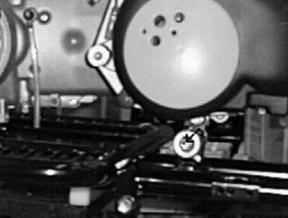
3.3 ENGINE INSTALLATION
Engine installation is essentially the reverse order of removal.
The torque of engine hanger bolt is 24-30 Nm
Route the wires and cable in reverse order properly.
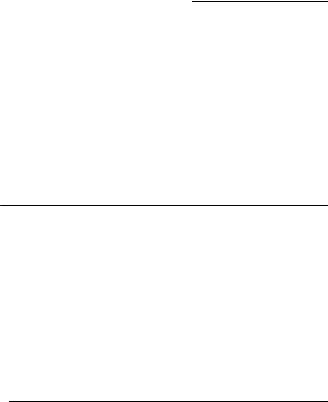
POORLY
LEAN MIXTURE
RICH MIXTURE
UNPROPER ADJUSTMENT TO THE
IDLE SPEED SCREW
IGNITION MALFUNCTION
FUEL/AIR MIXTURE RATIO NO GOOD
AIR CLEANER DIRTY
INSULATOR LEAKS
FUEL TANK CAP BREATHING HOLE CLOGGED
FUEL JET OF CARBURETOR CLOGGED
FUEL TANK CAP BREATHING HOLE CLOGGED
FUEL FILTER CLOGGED
FUEL FLOWS IN THE TUBE UNSMOOTHLY
FLOAT LEVEL IN CARBURETOR TOO LOW
FLOAT NEEDLE VALVE IN CARBURETOR FAULTY
FLOAT LEVEL TOO HIGH
AIR DUCT IN CARBURETOR IS CLOGGED
AIR CLEANER DIRTY

4. ENGINE FUEL SYSTEM
4.1 FUEL TANK |
4.2 CARBURETOR |
|
|
4.1 FUEL TANK
REMOVAL
Remove the seat and rear fender.
Disconnect the fuel line from the carburetor.
Remove the fuel tank cap and front fender.
Unscrew the fuel tank fixed bolts.
Note: Keep gasoline away from flames or sparks.
Wipe up spilled gasoline at once.
4.2 CARBURETOR
REMOVAL
Remove the air cleaner.
Disconnect the fuel line and auto-choke electric wire. Unscrew the intake pipe mounting bolts at the carburetor then removes the carburetor.
Note: Turn fuel cup on (off) position
Remove the carburetor cap.
Remove the throttle cable from the throttle valve while depressing the throttle valve spring.
Remove the needle clip retainer, the jet needle and needle clip. Inspect the throttle valve and
jet needle surface for wearness, scratches or dirt.

DISASSEMBLY
Unscrew the float chamber screws and remove the carburetor chamber.
carburetor chamber
Disassembly the float and float needle valve.
Inspect the seat of the float needle valve for wear or damage.
Disassembly the slow jet, main jet, throttle adjusting screw and air flow adjusts screw.
Inspect all the jets and screws for wear or damage. Clean the passages and jets with compressed air.
throttle adjusting screw
air flow adjusts screw
main jet
slow jet
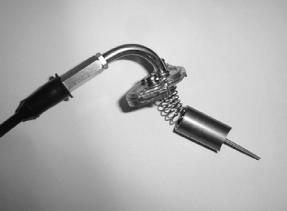
ASSEMBLY
Clean all parts in solvent and blow it dry with compressed air. Assembly is essentially the reverse order of disassembly.
THROTTLE VALVE ASSEMBLY
Install the needle clip on the jet needle. Install the jet needle into the throttle valve.
Assembly the throttle cable, spring and the throttle valve. Align the throttle valve groove with the idle speed adjust screw and install the carburetor cap to the carburetor.

5. ENGINE LUBRICATION AND COOLING SYSTEM
5.1 ENGINE LUBRICATION SYSTEM |
5.4 COOLING SYSTEM |
5.2 CAUTION |
5.5 TROUBLESHOOTING |
5.3OIL PUMP
5.1ENGINE LUBRICATION SYSTEM
The engine drives the pump gears of oil pump crankshaft. Pump gears rotate the plunger shaft in oil
pump. This shaft sent the lubricating oil into the crankcase to mix with the mixture of air-fuel flow evenly.
The oil drops and foam cover the cylinder inner wall, piston surface and piston rings.
5.2 CAUTION
Having enough oil supply to engine is very important.
If the oil quantity is not enough, this engine will be serious scratched, and then this engine will stop, even cannot work again.
When this engine is serious scratched, you need to change the piston, piston rings and cylinder together. Also you need to check the combustion system and lubrication system carefully.
5.3 OIL PUMP
The quantity of oil that deliver out from oil pump increased by the engine speed and the carburetor throttle open width. Oil pump is under the right side of the engine and connected by a control cable of throttle.
5.4 COOLING SYSTEM
The engine-cooling fan sucks the air.
The cooling fan is on the right side of engine. The air is forced to flow through cylinder fin and cylinder head. So, the cylinder and piston will not over heat.
5.5 TROUBLESHOOTING
NO ENOUGH OIL SUPPLY TO ENGINE |
|
|
THE OIL LEVEL IN OIL TANK IS TOO LOW. |
||
|
|||||
|
|
|
|
OIL TUBES WERE NOT FIXED WELL. |
|
|
|
|
|
OIL HAS LEAKAGED FROM TUBE ENDS. |
|
|
|
|
|
OIL TUBES WERE BROKEN. |
|
|
|
|
|
OIL TUBES WERE CLOGGED. |
|
|
|
|
|
OIL PUMP CANNOT WORK. |
|
ALWAYS INSUFFICIENT OIL LEVEL |
|
|
|
|
EXTERNAL OIL LEAKS |
|
|
|
|||
IN LUBRICATE OIL TANK |
|
|
|
WORN CYLINDE HEAD GASKET |
|
|
|
|
|
|
WORN PISTON RINGS |
